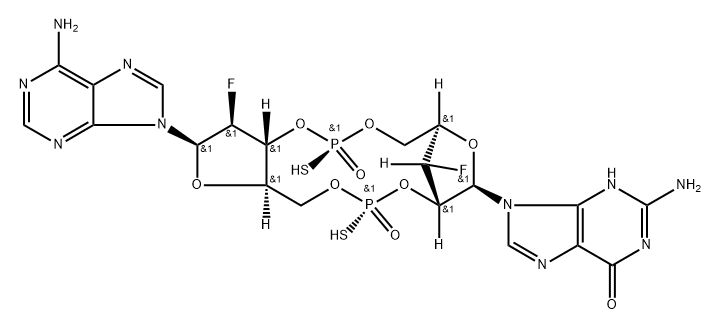| DC60034 |
STING inhibitor-1
|
STING inhbiitor, which inhibited the activation of the STING signal pathway and to prevent or treat a STING-mediated disease. |
| DC60033 |
STING INHIBITOR-2
|
STING inhbiitor, which inhibited the activation of the STING signal pathway and to prevent or treat a STING-mediated disease. |
| DC39220 |
STING agonist compound 17
|
STING agonist compound 17 is a selective stimulator of interferon genes (STING) receptor agonist. |
| DC39210 |
MSA-2 analogue
|
MSA-2 analogue is an orally available human STING agonist. |
| DC39031 |
MSA-2
|
MSA-2 is an orally available human STING agonist.MSA-2 is bound to STING as a noncovalent dimer. Extensive experimental analysis indicates that MSA-2 predimerization is required for binding. Acidic tumor microenvironments favor permeable, uncharged MSA-2. |
| DC39030 |
SR-717
|
SR-717 is a non-nucleotide, small-molecule STING agonist and functions as a direct cyclic guanosine monophosphate-adenosine monophosphate (cGAMP) mimetic that induces the same "closed" conformation of STING.SR-717 functions as a direct cyclic guanosine mo |
| DC28013 |
Cyclic-di-GMP(c-di-GMP)
|
Cyclic di-GMP (c-di-GMP) is one of the most important and common bacterial second messenger. It is involved in numerous prokaryotic processes, including biofilm formation, motility, virulence, and cell cycling. c-di-GMP also has functions in eukaryotic cells. It is detected by the transmembrane protein stimulator of interferon genes (STING), leading to activation of the innate immune system. |
| DC28012 |
c-Di-AMP(Cyclic-Di-AMP) ammonium salt
|
Bis-(3'-5')-cyclic dimeric adenosine monophosphate (c-di-AMP) is a bacterial second messenger implicated in the control of cell wall metabolism, osmotic stress responses and sporulation.
Detection of c-di-AMP by the host cytoplasmic surveillance pathway (CSP) is known to elicit type I IFN responses through a signaling axis that involves STING, TBK1 and IRF3 [1, 2].
Involvement of the helicase DDX41 in the recognition of c-di-AMP has been suggested [3].
Recent studies have also demonstrated that c-di-AMP exerts strong adjuvant activities when delivered by the mucosal route [4, 5]. |
| DC72041 |
BSP16
|
BSP16 is a potent, orally active stimulator of interferon genes (STING) agonist. BSP16 can selectively stimulate the STING pathway. BSP16 can be used for the research of cancer. |
| DC50039 |
3'3'-cGAMP (sodium salt)
|
3’3’-cGAMP Fluorinated (c-[2'FdGMP]-[2'FdAMP]) is a synthetic analog of cyclic guanosine monophosphate- adenosine monophosphate (cyclic GMP-AMP, cGAMP) with a fluorine atom at 2’ position of the nucleosides. 3’3’-cGAMP is a cyclic di-nucleotide produced by bacteria. It is also referred to as "canonical" cGAMP due the presence of the classical 3’-5’ phosphodiester linkages between the guanosine and the adenosine. It has been reported that cGAMP binds STING (stimulator of IFN genes) and subsequently induces TBK1-IRF3-dependent production of IFN-β [1].
The incorporation of fluorine into biologically active molecules is commonly used in medicinal chemistry to improve their metabolic stability or to modulate physicochemical properties such as lipophilicity [2, 3]. Moreover, the introduction of a fluorine atom can change the biological activities of a molecule. Interestingly, when used at low concentrations in various cellular assays, 3’3’-cGAMP Fluorinated induces higher levels of type I IFNs than does cGAMP.
STING ligands such as cGAMP induce type I IFNs and activate interferon stimulated genes (ISG) through IRFs. To facilitate their study, InvivoGen has developed stable reporter cells in two well established immune cell models: THP-1 human monocytes and RAW 264.7 murine macrophages. These cells express a reporter gene (SEAP or Lucia luciferase), under control of an IRF-inducible promoter. |






















